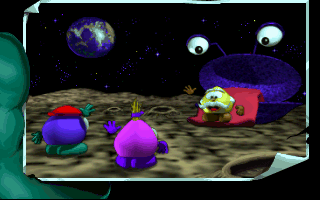Retro Replay Review
Gameplay
SpaceKids offers a uniquely paced interactive experience that blends animated cutscenes with timely player inputs. Much like the classic Dragon’s Lair model, the adventure unfolds through non-interactive segments where you watch Grandpa of Zeet and Deedle’s grandchildren navigate bizarre Earth-bound environments. These animated vignettes set the stage for quick-response moments in which you must guide the characters left, right, up, or down to overcome obstacles—or sometimes simply choose the correct visual cue to progress the story.
(HEY YOU!! We hope you enjoy! We try not to run ads. So basically, this is a very expensive hobby running this site. Please consider joining us for updates, forums, and more. Network w/ us to make some cash or friends while retro gaming, and you can win some free retro games for posting. Okay, carry on 👍)
Unlike its contemporaries, SpaceKids eases the pressure by allowing for multiple attempts when a maneuver fails. This forgiving design means younger players won’t be locked out of content by a single misstep, and more casual audiences can enjoy the whimsical narrative at a relaxed pace. Each challenge is generally self-contained: fail, and you’re immediately presented with the same scene again, ready for another try. This approach dramatically reduces frustration and keeps the focus on exploration of the surreal world rather than repeated trial-and-error.
Controls are intentionally simple, relying on directional inputs and occasional button presses. While the simplicity may feel limiting to seasoned gamers, it’s ideal for the target demographic of children or families looking for a lighthearted experience. The timing windows are generous, and the save points—tied to scene transitions—ensure you’re never too far from your last checkpoint. For players seeking a more demanding challenge, the consistent pacing and multiple retry opportunities still offer room to master each segment’s nuances.
Graphics
The visual presentation of SpaceKids captures a transitional era in game design, just before CD-ROMs took over with digitized video. Instead of bulky full-motion video, you get meticulously crafted, byte-thrifty pre-rendered sprites layered over 3D backdrops. As you move through candy-colored forests or glitchy cityscapes, characters and enemies stretch, skew, and rotate in real time to create the illusion of depth and motion. It’s a clever workaround for hardware limitations, lending the game a charmingly retro look.
Every object that isn’t a piece of candy wears a comically oversized pair of pleading eyes—trees blink, boulders grimace, and even household appliances beam with childlike enthusiasm. This anthropomorphic design choice unifies the art direction and gives SpaceKids a surreal, storybook quality. Though the textures are low-resolution by modern standards, the bold color palette and playful animations ensure the world always feels lively, vibrant, and a little bit strange.
Lighting and shading effects are modest but effective, with pre-rendered backgrounds providing dramatic skies and sweeping landscapes. Character sprites sometimes pop against their environments, but this contrast enhances visibility during critical gameplay moments. Overall, the graphics may not impress hardcore 3D aficionados, but they faithfully evoke the charm of early multimedia titles and remain engaging for players drawn to whimsical, cartoon-inspired visuals.
Story
At the heart of SpaceKids lies a delightfully simple but compelling premise: Grandpa of Zeet and Deedle, a renowned explorer, has vanished on Earth, and it’s up to his grandchildren to rescue him. This straightforward setup allows the game to introduce a parade of eccentric characters—talking lollipops, grinning lampposts, and shape-shifting animals—each offering cryptic hints or obstacles in the rescue mission. The narrative unfolds in bite-sized chunks, perfectly tailored to the game’s interactive format.
Despite its episodic structure, SpaceKids weaves a cohesive thread through each level. Whether you’re navigating a jellybean minefield or outwitting a neon-clad street performer, every scene reinforces the whimsical tone. Dialogue is sparse but memorable, favoring short exclamations and humorous sound effects to convey personality. This minimalist approach leaves plenty of room for players to project their own imaginations onto the story, making the journey feel personalized and unpredictable.
The game’s pacing strikes a balance between leisurely exploration and moments of tension, such as when Grandpa’s faint voice echoes in the distance or when a looming threat forces a sudden split-second decision. Although the plot never dives into heavy drama, it builds enough emotional stakes to keep players engaged—especially younger ones eager to reunite the family. By the time you corner Grandpa in a candy-frosted fortress, the simple act of bringing him home feels genuinely rewarding.
Overall Experience
SpaceKids stands out as a charming relic of pre-CD-ROM interactive cinema, offering a light adventure that prioritizes whimsy over complexity. Its forgiving gameplay loop makes it accessible to players of all skill levels, particularly young audiences or anyone nostalgic for the early days of multimedia gaming. Replay value lies in perfecting your timing and discovering every quirky character that dots the Earth-themed levels.
While modern gamers accustomed to deep narratives and fully realized 3D worlds may find SpaceKids quaint or simplistic, its artful sprite work and surreal design maintain a distinct personality. This isn’t a high-octane action title—it’s a playful, story-driven romp that invites you to slow down, enjoy the scenery, and relish each unexpected twist. For families seeking a cooperative viewing experience or solo players in search of a retro diversion, SpaceKids delivers.
Ultimately, the game’s greatest strength is its ability to evoke wonder through minimal means. By leaning into creative sprite animation, vibrant backdrops, and a heartfelt rescue mission, SpaceKids crafts an experience that feels larger than its technical constraints. If you appreciate interactive movie-style games and have a soft spot for offbeat characters and light challenges, SpaceKids is well worth a trip back to the early ’90s multimedia era.
 Retro Replay Retro Replay gaming reviews, news, emulation, geek stuff and more!
Retro Replay Retro Replay gaming reviews, news, emulation, geek stuff and more!









Reviews
There are no reviews yet.